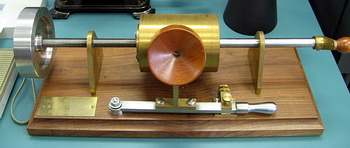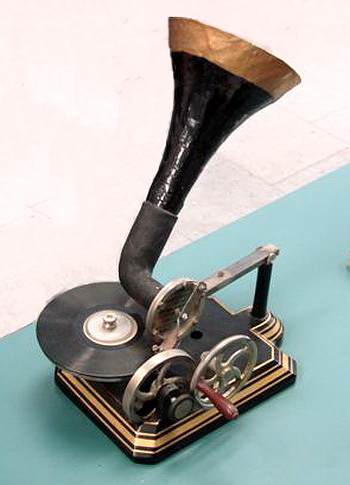|
Unusual Machines
by Mark Caruana
[Editorís note: The January 11, 2009, presentation to CAPS featured 'interesting and unusual machines' from the collections of our members.
This article is the last of three intended to feature the machines presented at that time.]
|
Replica Parlor Tinfoil Phonograph
This exact replica Edison Parlor tinfoil phonograph was one of 25 commissioned by Ray Phillips, who has the original from which
the parts were cast. This machine works remarkably well and I have successfully used it for demonstrations many times. The original
version of the Parlor model was manufactured by Sigmund Bergmann in early 1879 and sold for a price of $15. In late 1879 the second
version (this one) was manufactured by the Brehmer Brothers and sold for $10. Even with the price reduction, few Parlor Phonographs
were sold and as a result they are extremely rare. The Brehmer Brothers version has a raised collar on the left side of the mandrel
so that, if the tinfoil were removed, it could be repositioned on the mandrel to replay the recording later. In practice this never
works very well.
|

|
|
Replica Parlor Tinfoil Phonograph
(Photo courtesy Betty Pratt)
|
|
|
|
|
Replica Hardy Tinfoil Phonograph
This exact replica Edme Hardy tinfoil phonograph was another machine commissioned by Ray Phillips, who has the original from which
the parts were cast. This machine also works well and is a faithful replica. In February, 1878, Edison shipped this new model to
his representative in France as a sample to be reproduced there. Parisian machinist Edme Hardy was contracted to manufacture this
version and it is estimated that 500 of these were produced for sale at $40 US each. This machine is superior in design to the
Parlor phonograph in that finer adjustments can be made to the depth of projection of the needle into the tinfoil and in the alignment
of the tinfoil. Surprisingly, however, I have had better success demonstrating the Parlor phonograph.
|

|
|
Replica Hardy Tinfoil Phonograph
(Photo courtesy Betty Pratt)
|
|
|
|
|
Gillett Tinfoil Phonograph
Gillett tinfoil phonographs were never commercially produced, as all are built from a set of plans from a book titled
The Phonograph and How to Construct It, by W. Gillett in 1892. For many years builders have used these plans to construct
this well-designed machine. This version was built by Paul Gildea from Sandy Hook, Connecticut
and I have found that it works as well as any of the tinfoils I have. Originally when I received it, the feed screw had a slight bend
and I was very pleased with how Paul took it back and fixed it free. Over the years, a number of these machines have shown up on
e-Bay and they tend to sell for a very reasonable price.
|

|
|
Gillett Tinfoil Phonograph
(Photo courtesy Betty Pratt)
|
|
|
|
|
Replica Berliner Hand-Driven Kammer & Reinhardt Gramophone
Yet another replica machine commissioned by Ray Phillips. This small machine is again a faithful reproduction of a rare piece
from the dawn of sound reproduction. Having compared this to an original, I am satisfied that it plays and sounds as well as the
original, which is not to say much. When Emile Berliner developed his design for the disc talking machine in the late 1880s, he
contracted the firm of Kammer & Reinhardt in Germany to manufacture this toy which was distributed in Europe and Britain in the
early 1890s. The 5-inch records manufactured for this machine are as exceedingly rare as the machine.
|

|
|
Replica of a Berliner hand-driven Kammer & Reinhardt gramophone
(Photo courtesy Betty Pratt)
|
|
|
|
|